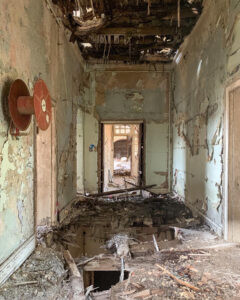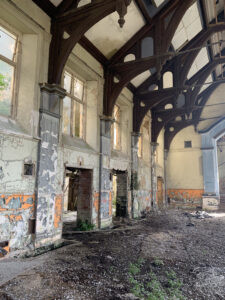By Shannine O’Neill
GHOSTLY VOICES have been heard throughout the halls of this asylum where those struggling with mental health issues were giving electroshock therapy and lobotomies.
Creepy images show a decaying staircase leading down to the basement where disembodied voices have been heard.
Another photograph shows a painting of cats and flowers around a door frame, signifying a time when the halls would be bright and buzzing with people.
Urban Explorer Emma (29) from Hertfordshire, UK explored the abandoned St John’s Asylum in Lincolnshire, UK for over three hours where she heard ghostly whisperings and eerie paintings on the walls.
St John’s Hospital, once known as St John’s Asylum, had been abandoned since 1989 until 2012 when it was bought by a property developer who replaced the area with luxury homes and apartments that still keep a lot of the original architecture.
The hospital opened in 1852 as the Lincolnshire County Lunatic Asylum after the 1845 act of parliament which made it mandatory for each county to provide accommodation for what they referred to as ‘lunatics’.
The hospital housed around 250 patients when it first opened its doors, but by the time of its closure, it was able to house over 944 patients.
The interwar period brought new light to the stigma surrounding asylums, and so in 1919 the hospital became Bracebridge Mental Hospital.
Electroshock therapy, brain surgery and lobotomies were common ways in which many patients would have been ‘cured’, whether they were suffering from postpartum depression or schizophrenia.
During WWII it served as an Emergency Hospital and gained patients from Rauceby mental hospital when it was taken over by the Royal Air Force for a brief time.
By the early 1980’s outlying wards were closed, long stay patients were discharged through resettlement programs and a series of mental health units were developed in the district general hospitals, leaving it to be abandoned in 1989.
“The hospital opened in 1852 as the Lincolnshire County Lunatic Asylum,” she said.
“It was built along with many others, in response to the 1845 act of parliament which made it mandatory for each county to provide accommodation for its ‘lunatics’.
“A rural, flat, open site along the main Lincoln to Sleaford road offered a readily available supply of cheap farming land with which to provide produce to support the population of the asylum.
“The building was executed with separate male and female wings either side of a central services block, with the Superintendent’s residence occupying the main portion of frontage of the south and decorated with a porch and pediment.

“Behind the wards were blocks for more difficult patients.”
In its peak, the hospital could house over 944 patients after many developments and reconstructions over the years.
“Over the years, the hospital was expanded and numerous additions incorporated to cope with the increasing numbers and the need for better facilities,” she said.
“In 1858 Thomas Parry designed a cemetery and a mortuary chapel was consecrated in 1855 as the local burial ground was unable to support the volume of pauper burials from the asylum.
“Additional wards were also added and in 1882 further wings extended either side of the main front. In 1869 a detached chapel was built replacing the original within the asylum.

“A larger programme of expansion designed by A. Richmond and Sons took place during the 1930’s with an admissions hospital and staff housing adjacent to the isolation hospital, which was intended to be a largely separate unit from the main asylum with its own entrance.
“The aim was for patients to be admitted and treated in the early phase of their illness when they were perceived to be most curable, in the hope that they would never require admission to the main building.”
Although the hospital had what was thought at the time as ‘forward-thinking’ when it came to mental health, it is still guilty of being uneducated and putting patients through unnecessary procedures for their diagnoses.
“Like many asylums, the hospital is guilty of using some of the traditional medical techniques of its day to ‘cure’ insanity,” she said.
“This included electric shock treatment.
“Conditions such as depression and post natal depression were classed and treated the same as someone with schizophrenia.
“Brain surgery was also believed to be a cure for mental illness and was commonly used. This involved hours of drilling into patients’ skulls.”
When exploring the building, Emma found there to be a feeling of unease in the air when thinking about the sorrow of what the patients experienced there.

“Walking around the asylum felt surreal,” she said.
“It was sad to think of how patients would have been treated during the time they were there when there was less of an understanding of mental health.
“There was lots of paint peel and even traces of wallpaper and imagery left on the walls.
“The hospital closed in December 1989 and was left abandoned for over 20 years until fairly recently when the site was sold to a property developer.”
While in the basement area, Emma thought she even heard whispered voices speaking to each other, even though she was the only person in the building.
“Whilst it was empty the corridors echoed the memories of the past,” she said.
“It had quite an eerie feel.
“Whilst downstairs in the basement area I was pretty certain I heard what sounded like a whispered conversation.
“But I was definitely the only one there at the time.”
ENDS










